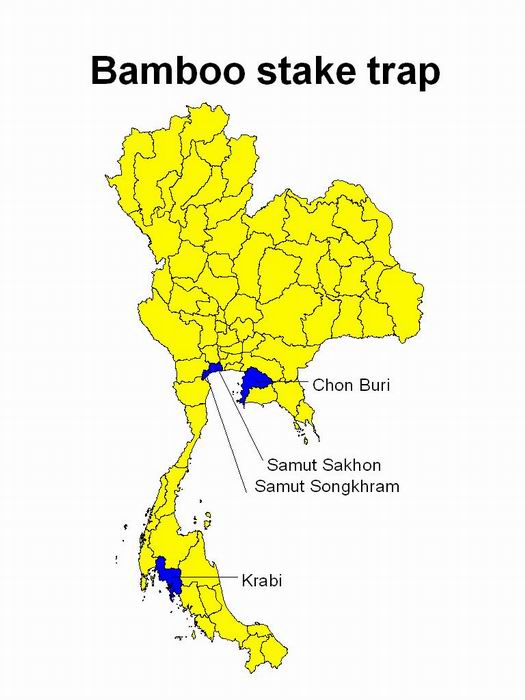Bamboo stake trap
The
term ‘bamboo stake trap’ includes a variety of
rather large and complex stationary fishing gears used in
coastal waters up to 20 meters depth. A common characteristic
of all such gears, irrespective of size, is that they consist
of three parts: leaders, playground and cod-end. Leaders,
whose purpose is to guide the fish in to the trap, are made
of bamboo stakes, netting or branches. There are 2-5
leaders in a set. Their length varies from 10 to 800 meters,
depending on the size of trap. The leaders guide the
fish into the playground, which is a C-shaped or triangular
enclosure constructed of bamboo or wooden stakes driven into
the sea bed, with or without the polyethylene netting cover. The
exit from the playground takes the fish into the cod-end,
from where they are scooped or otherwise removed. The
cod-end is semicircular, with a bamboo or palm-tree stake
frame and polyethylene or chicken-wire netting. A funnel-shaped,
no-return entrance prevents the fish from escaping. Some
cod-ends have a part which can be hauled, to collect the
catch.
Bamboo
stake traps are usually positioned so that their main leader
(the longest one) is perpendicular to the shore, and the
opening of the trap faces the current at the ebb-tide.
According
to the method of operation, bamboo stake traps can be classified
as follows:
-
Ebb-tide bamboo stake trap,
-
Bamboo stake trap with net operation, and
-
Bamboo stake trap with a removable bag-net.
The
ebb-tide bamboo stake trap is a small-scale gear, usually set on a sand-bar
at the mouth of a river, in up to 5 m water depth. The leaders are 10-400
m long, made of polyethylene netting. The play-ground is from 2.5 x 4
to 8 x 10 m large. The size of the cod-end is between 1.5 x 2.5 and 2
x 3 m. Both the playground and the cod-end are covered with polyethylene
netting. The height of the trap is 3 to 5 meters. The catch. Which
includes shrimps, cuttlefish, anchovies and trash-fish, is taken out by a scoop-net
daily at spring-tide and once every few days at neap-tide. Sometimes
a luring lamp is used at the cod-end to attract shrimps and squid. The
gear is found in Samut Sakhon, Samut Songkhram and Krabi provinces.
The
bamboo stake trap with net operation is a large-scale
gear, used in coastal waters with 5-20 m depth. It
has four or five bamboo stake leaders, 100-300 m long. There
is a small playground (this is sometimes omitted) and a
large cod-end, between 16 x 25 to 25 x 40 m in size, covered
with polyethylene netting and chicken-wire netting at the
bottom. A rectangular purse-seine is used for fishing
operation. This net has 8 mm mesh-size, nylon 210
d/5 rachel netting. A long pole serves to push the
net so that it surrounds the fish in the cod-end. The
net operation is carried out twice daily, at high and low
tide. The catch consists mainly of Indo-Pacific mackerel,
anchovies, pony-fish, croakers and trash-fish. The
gear used to be very popular in the past, and can still
be found at Leam Than in Chon Buri province.
The
bamboo stake trap with a removable bag-net is the largest
stationary trap. Its construction differs from the
bamboo stake trap with net operation only in the cod-end. In
the present case, the cod-end is a C-shaped enclosure made
of coconut tree-trunks, and a removable bag-net is set
in the cod-end. The size of the cod-end is 30 x 50
meters. Four bamboo stake leaders, 700-750 m long,
stretch between the shore and the playground of the net. The
playground covers an area of 30 x 40 m, and the funnel-shaped
entrance to the cod-end is 2.5 m wide. The trap is
set at about 10-20 meters depth. The bag-net, which
is made of 10 mm mesh-size rachel netting, is hung inside
the cod-end enclosure in such a way that its upper edge
is fastened to the top of the poles and its bottom edge
is held down by ropes passing through pulleys at the bottom
of each pole. At the entrance to the cod-end, the
net is stretched on six bamboo poles by means of 10-15
iron rings and weighted down with cement sinkers. The
bag net with catch is lifted when required. The
catch are anchovies, Indo-Pacific mackerel, squid etc. The
fishing season is between April and January, in waters
off Samut Sakhon and Samut Songkhram.

|